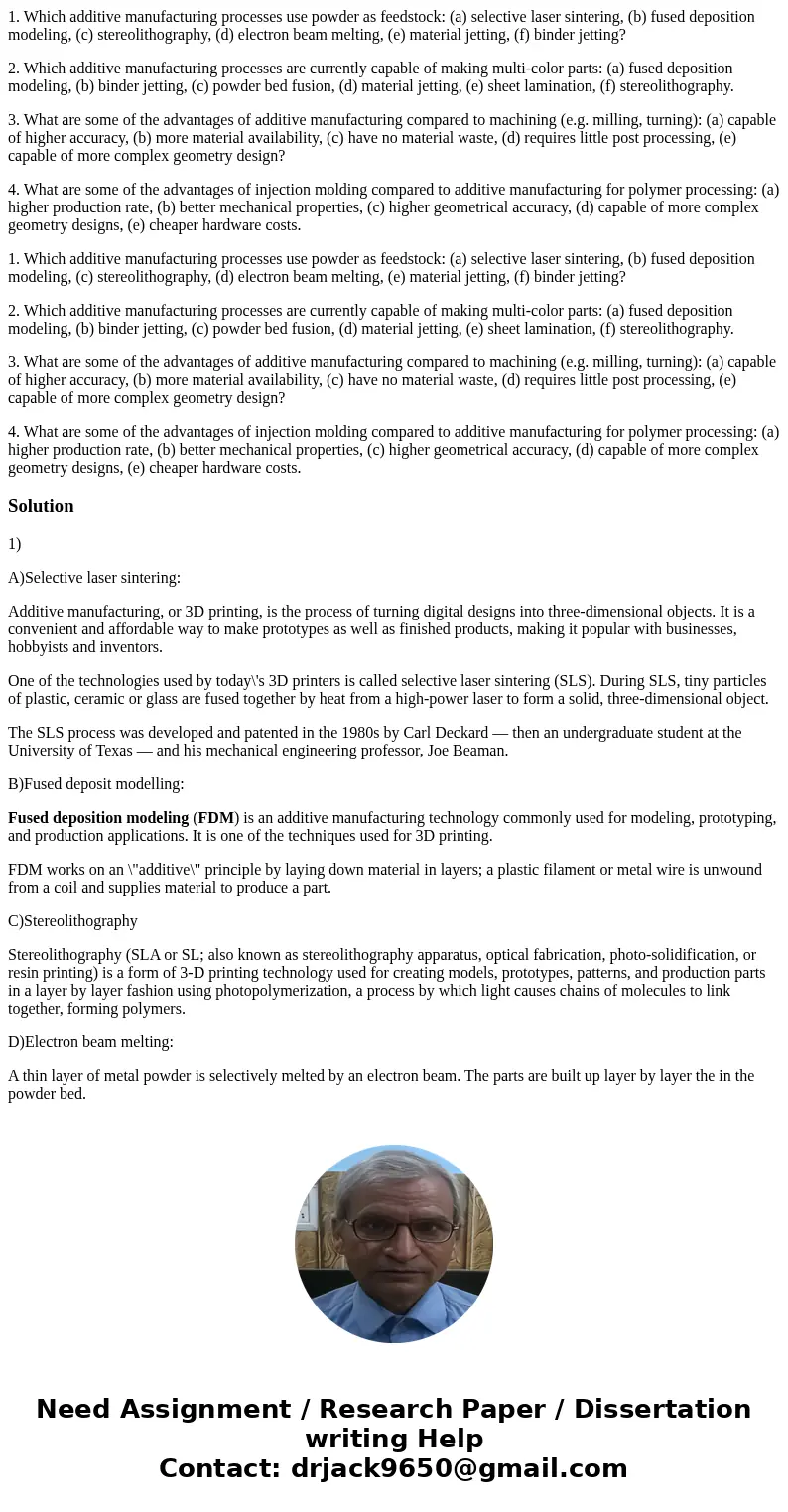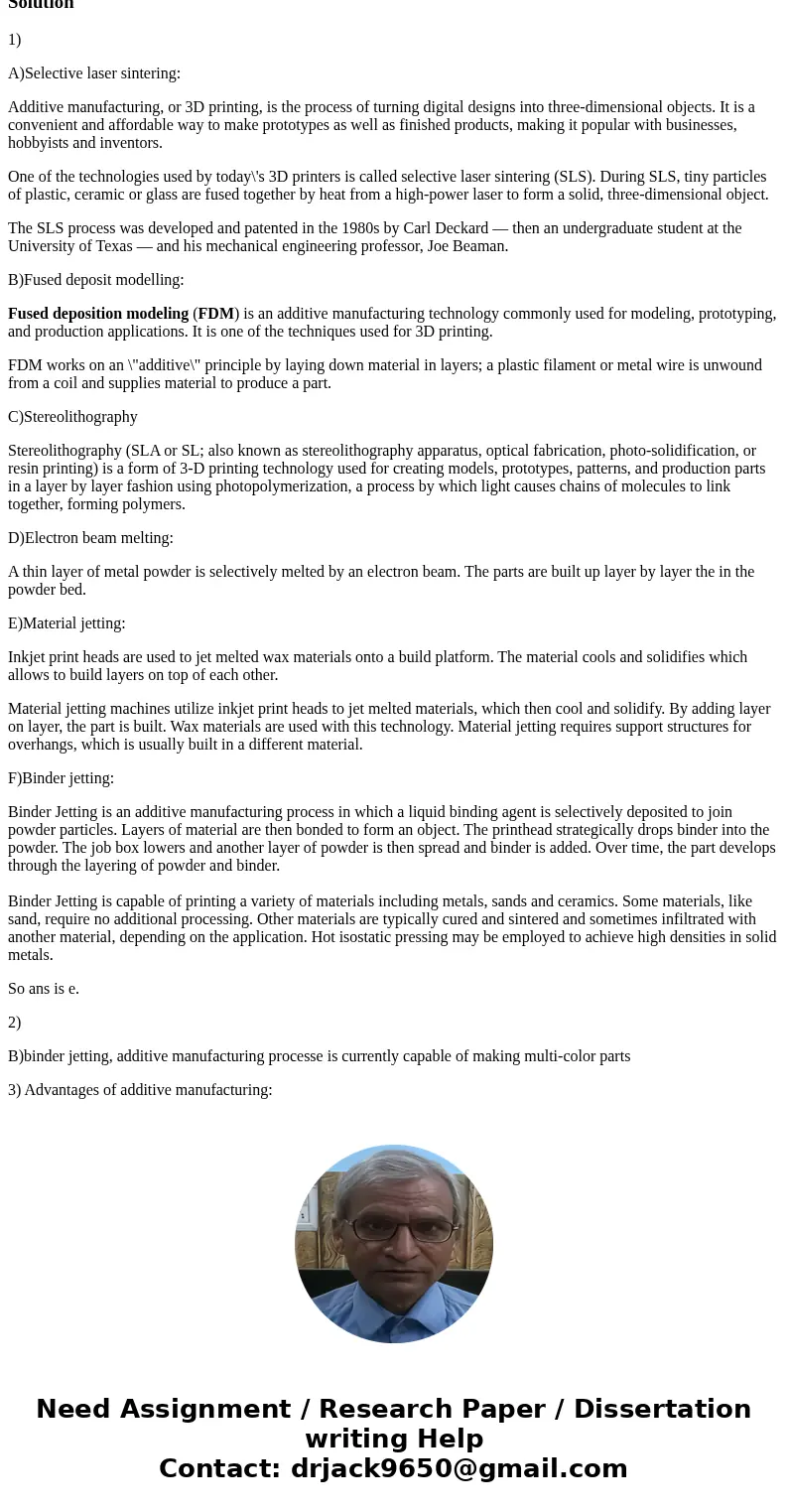1 Which additive manufacturing processes use powder as feeds
1. Which additive manufacturing processes use powder as feedstock: (a) selective laser sintering, (b) fused deposition modeling, (c) stereolithography, (d) electron beam melting, (e) material jetting, (f) binder jetting?
2. Which additive manufacturing processes are currently capable of making multi-color parts: (a) fused deposition modeling, (b) binder jetting, (c) powder bed fusion, (d) material jetting, (e) sheet lamination, (f) stereolithography.
3. What are some of the advantages of additive manufacturing compared to machining (e.g. milling, turning): (a) capable of higher accuracy, (b) more material availability, (c) have no material waste, (d) requires little post processing, (e) capable of more complex geometry design?
4. What are some of the advantages of injection molding compared to additive manufacturing for polymer processing: (a) higher production rate, (b) better mechanical properties, (c) higher geometrical accuracy, (d) capable of more complex geometry designs, (e) cheaper hardware costs.
1. Which additive manufacturing processes use powder as feedstock: (a) selective laser sintering, (b) fused deposition modeling, (c) stereolithography, (d) electron beam melting, (e) material jetting, (f) binder jetting?
2. Which additive manufacturing processes are currently capable of making multi-color parts: (a) fused deposition modeling, (b) binder jetting, (c) powder bed fusion, (d) material jetting, (e) sheet lamination, (f) stereolithography.
3. What are some of the advantages of additive manufacturing compared to machining (e.g. milling, turning): (a) capable of higher accuracy, (b) more material availability, (c) have no material waste, (d) requires little post processing, (e) capable of more complex geometry design?
4. What are some of the advantages of injection molding compared to additive manufacturing for polymer processing: (a) higher production rate, (b) better mechanical properties, (c) higher geometrical accuracy, (d) capable of more complex geometry designs, (e) cheaper hardware costs.
Solution
1)
A)Selective laser sintering:
Additive manufacturing, or 3D printing, is the process of turning digital designs into three-dimensional objects. It is a convenient and affordable way to make prototypes as well as finished products, making it popular with businesses, hobbyists and inventors.
One of the technologies used by today\'s 3D printers is called selective laser sintering (SLS). During SLS, tiny particles of plastic, ceramic or glass are fused together by heat from a high-power laser to form a solid, three-dimensional object.
The SLS process was developed and patented in the 1980s by Carl Deckard — then an undergraduate student at the University of Texas — and his mechanical engineering professor, Joe Beaman.
B)Fused deposit modelling:
Fused deposition modeling (FDM) is an additive manufacturing technology commonly used for modeling, prototyping, and production applications. It is one of the techniques used for 3D printing.
FDM works on an \"additive\" principle by laying down material in layers; a plastic filament or metal wire is unwound from a coil and supplies material to produce a part.
C)Stereolithography
Stereolithography (SLA or SL; also known as stereolithography apparatus, optical fabrication, photo-solidification, or resin printing) is a form of 3-D printing technology used for creating models, prototypes, patterns, and production parts in a layer by layer fashion using photopolymerization, a process by which light causes chains of molecules to link together, forming polymers.
D)Electron beam melting:
A thin layer of metal powder is selectively melted by an electron beam. The parts are built up layer by layer the in the powder bed.
E)Material jetting:
Inkjet print heads are used to jet melted wax materials onto a build platform. The material cools and solidifies which allows to build layers on top of each other.
Material jetting machines utilize inkjet print heads to jet melted materials, which then cool and solidify. By adding layer on layer, the part is built. Wax materials are used with this technology. Material jetting requires support structures for overhangs, which is usually built in a different material.
F)Binder jetting:
Binder Jetting is an additive manufacturing process in which a liquid binding agent is selectively deposited to join powder particles. Layers of material are then bonded to form an object. The printhead strategically drops binder into the powder. The job box lowers and another layer of powder is then spread and binder is added. Over time, the part develops through the layering of powder and binder.
Binder Jetting is capable of printing a variety of materials including metals, sands and ceramics. Some materials, like sand, require no additional processing. Other materials are typically cured and sintered and sometimes infiltrated with another material, depending on the application. Hot isostatic pressing may be employed to achieve high densities in solid metals.
So ans is e.
2)
B)binder jetting, additive manufacturing processe is currently capable of making multi-color parts
3) Advantages of additive manufacturing:


 Homework Sourse
Homework Sourse